Worcestershire Exhibition of Art and Industry
- 20th July 2022
140 years ago The Worcestershire Exhibition took place at Shrub Hill, Worcester. Running from 15th July to 15th October 1882, The Worcester Exhibition in the empty Worcester Engine Works shed at Shrub Hill exhibited items loaned by people and businesses from throughout Worcestershire.
On opening day bells were rung, flags were flown, and the streets were decorated with streamers and bunting. Crowds lined the roads to watch the ‘great and good’ of the county arrive and to admire the parading soldiers, brass bands, mayors and other dignitaries.
The fine arts section displayed over 600 paintings, statues, architectural drawings, metalwork, ivories, China, and needlework. There was a historical section with books, pictures, curiosities and furniture, and an industrial section with items displayed from businesses across the county. Some of these displays include:
Sir A. Blomfield, a local architect, submitted Perspective Drawing of New Church at Upton-upon-Severn in the architectural drawings class of the exhibition.
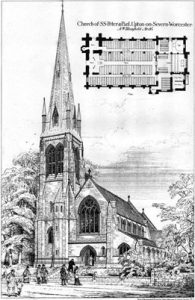
In the historical gallery Mr Martin provided many paintings and portraits including the Portrait of Erasmus of Rotterdam by Hans Holbein the Younger. Desiderius Erasmus of Rotterdam (1466/69–1536) was a renowned humanist scholar and theologian. In 1521 he moved to Basel, the city where Hans Holbein the Younger lived and had his workshop. Such was the fame of Erasmus, who corresponded with scholars throughout Europe, that he needed many portraits of himself to send abroad to his protectors. The version shown below is a copy of his portrait from the national gallery.
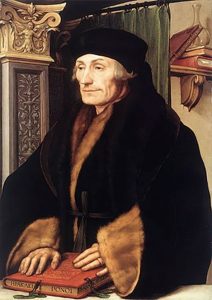
Rembrandt’s Susanna and the elders, now on display in the Gemäldegalerie Berlin, is one of his most important works taken from the Old Testament where a rich man named Joakim lived in Babylon with his beautiful, godly wife Susanna who is propositioned by two old judges when bathing and almost executed as a result. Rembrandt captured the scene as Susanna has the two old men take her by surprise. Rembrandt attempted this painting 3 times over more than twelve years and an astonishing number of drawings and studies on the theme. It was donated to the exhibition by the Lechmere family who had been in possession of the painting since 1801.
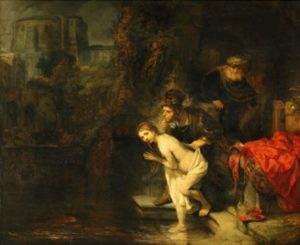
The exhibitions catalogue also lists another donation from the Lechmere family, the painting Saint Christopher and the Infant Child by Lucas Cranach. The painting depicts the story of Saint Christopher who devoted his life to carrying the weak and poor across a river. One night, when he was carrying a child, he felt his burden grow heavier with each step. When questioned, the child declared that he was Christ, and that Christopher was thus bearing the weight of the world.
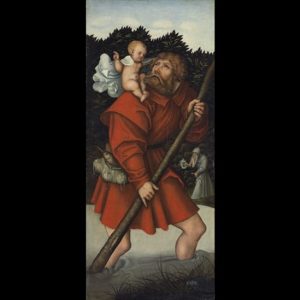
Described in the catalogue as Rembrandt’s Wife as a Jewish Bride, Rembrandts painting colloquially known as the Jewish Bride was officially called ‘Portrait of a Couple as Isaac and Rebecca’ and it was acquired by the City of Amsterdam in 1885 for the Rijksmuseum. The sitters may have been Rembrandt’s son Titus and his wife, and the subject is supposed to be the biblical couple Isaac and Rebecca, travelling with Rebecca disguised as Isaac’s sister, not his wife fearing trouble from the locals because of her beauty, but they were caught in a moment of intimacy.
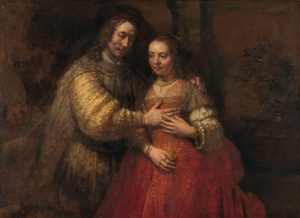
The exhibition is estimated to have had upwards of 200,000 attendees. Of the visitors to the exhibition a large proportion consisted of artisans and working classes. There was also reported to be many school students who attended.
The exhibition made £10,044 (Which would be roughly £1,287,421 today), cost £8500 (£1,090,000) in expenses, so made roughly £1555 (£200,000) profit. The profit was used to promote literature, science art and industry in Worcester. Some of this money helped build the Victoria Institute in Foregate Street, Worcester, now the city museum and art gallery.
It was reported that the lasting effects of the exhibitions had a very positive effect on Worcestershire industry. Berrows Worcester Journal is quoted at stating:
“Such a rare collection of art and historical treasures has afforded an opportunity for the refinement of taste, the cultivation of the imagination, and an appreciation of beauty of form”
“It would always be a matter of profound satisfaction to the inhabitants of the city and county that they had been able to bring together such a collection of works of art and industry, if not entirely from within the boundaries of the county.”
This post was researched and written by Sarah Dentith and David Hunt. All pictures used are either property of Worcestershire Archives and Archaeology Service or credited and covered by creative commons.
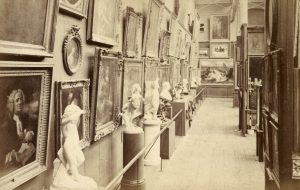
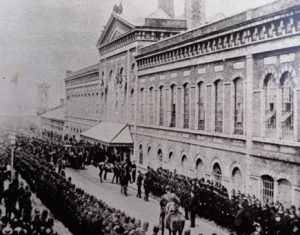
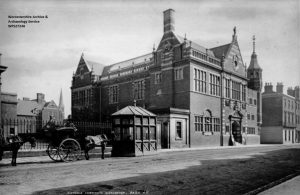
Post a Comment